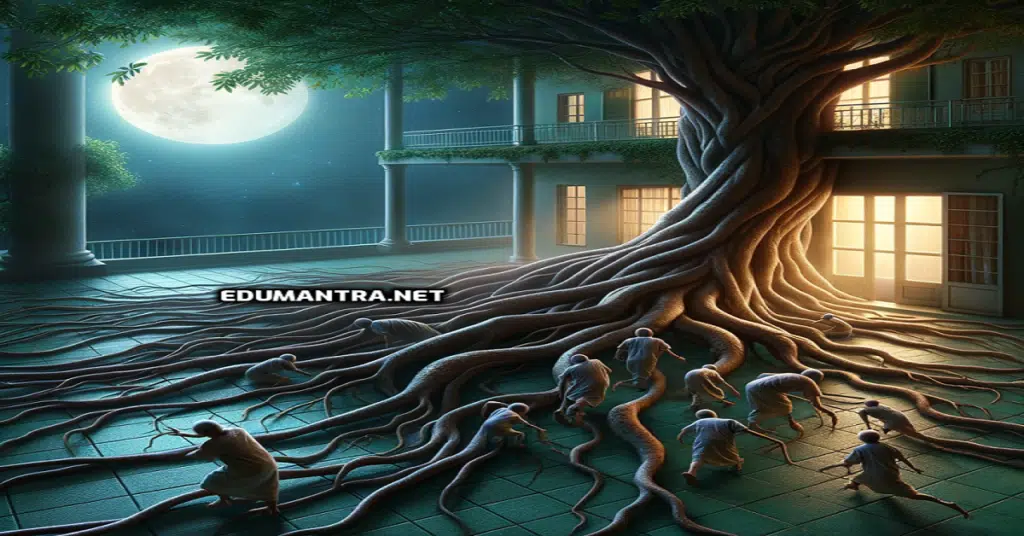
Here is The Trees, a detailed exploration and explanation of the figure of speech and its many facets. In this post, we have explained various examples of figurative speech, providing a comprehensive understanding of The Trees in terms of all Poetic Device. We have also told the reason why a particular figure of speech occurs in a particular line. This is going to help the children of various classes Class X. Dive in for figure of speech examples-
Figure of Speech in The Trees Stanza: – 1
“The trees inside are moving out into the forest,
the forest that was empty all these days
where no bird could sit
no insect hide
no sun bury its feet in shadow
the forest that was empty all these nights
will be full of trees by morning.”
1. Figure of Speech: Personification
Exact Line: “The trees inside are moving out into the forest,”
Reason: Trees are given human-like abilities to move, suggesting a dynamic, animate quality to nature.
2. Figure of Speech: Personification
Exact Line: “no sun bury its feet in shadow”
Reason: This line personifies the sun by attributing it with human-like characteristics, specifically feet that can be buried. This personification creates a vivid image of the sun engaging actively with the environment, enhancing the mystical atmosphere of the poem.
3. Figure of Speech: Hyperbole
Exact Line: “the forest that was empty all these days”
Reason: This is an exaggeration for effect. It’s unlikely the forest was literally empty, but this conveys a sense of profound emptiness or desolation.
4. Figure of Speech: Imagery
Exact Line: “where no bird could sit / no insect hide / no sun bury its feet in shadow”
Reason: These lines create vivid visual images in the reader’s mind, portraying a lifeless, static environment.
5. Figure of Speech: Contrast
Exact Line: “the forest that was empty all these days” vs. “will be full of trees by morning”
Reason: This contrast between emptiness and fullness highlights the dramatic change taking place in the forest.
Also Read:
- Hard Words : The Trees
- The Trees- Extra Questions and Notes
- The Trees NCERT Solution
- The Trees- Important Extra Questions- Long Answer Type
- The Trees- Important Extra Questions- Short Answer Type
6. Figure of Speech: Repetition
Exact Line: “the forest that was empty all these days” and “the forest that was empty all these nights”
Reason: The repetition of “the forest that was empty” emphasizes the theme of emptiness and the passage of time.
7. Figure of Speech: Synecdoche
Exact Line: “no sun bury its feet in shadow”
Reason: Using ‘feet’ to represent the sun is a form of synecdoche, where a part is used to represent the whole, adding a creative dimension to how sunlight interacts with the forest.
8. Figure of Speech: Negative Imagery
Exact Line: “where no bird could sit / no insect hide”
Reason: The use of negation in describing what birds and insects cannot do creates a stark image of an uninhabited, lifeless place.
9. Figure of Speech: Oxymoron
Exact Line: “empty all these days” and “full of trees by morning”
Reason: The juxtaposition of ’empty’ and ‘full’ in close proximity creates an oxymoron, reinforcing the stark contrast and the sudden, miraculous change in the forest.

Also Read:
- The Trees- Important Extra Questions- Very Short Answer Type
- The Trees- Extract Based comprehension test Questions
- The Trees- Comprehension Passages
- The Trees- Summary in Hindi – Full Text
- The Trees- Value Points of the Poem
The Trees Poetic Device- Stanza- 2
All night the roots work
to disengage themselves from the cracks
in the veranda floor.
The leaves strain toward the glass
small twigs stiff with exertion
long-cramped boughs shuffling under the roof
like newly discharged patients
half-dazed, moving
to the clinic doors.
Read the following analysis of the poem Trees for class 10 stanza 2. Each of these figures of speech enhances the vivid imagery of the stanza, making the natural elements appear lifelike and dynamic, imbuing them with human-like qualities or actions. This personification and metaphorical language deepen the reader’s connection to the natural world depicted in the poem.
1. Figure of Speech: Personification
Exact Line: “All night the roots work”
Reason: Roots are given human-like ability to “work,” suggesting an intentional, purposeful action typically associated with humans.
2.Figure of Speech: Personification
Exact Line: “The leaves strain toward the glass”
Reason: The leaves are described as “straining,” attributing them with human-like effort or struggle.
3. Figure of Speech: Personification
Exact Line: “small twigs stiff with exertion”
Reason: Twigs are described as being “stiff with exertion,” ascribing them human qualities of physical effort and fatigue.
4.Figure of Speech: Personification
Exact Line: long-cramped boughs shuffling under the roof
Reason: The boughs are described as “shuffling,” a human action, suggesting they move with difficulty or in a cramped manner.
5. Figure of Speech: Simile
Exact Line: “long-cramped boughs shuffling under the roof like newly discharged patients”
Reason: This line uses “like” to compare the movement of the boughs to newly discharged patients, suggesting a similarity in their slow, perhaps weakened, movements.
6. Figure of Speech: Metonymy
Exact Line: “the roots work… the leaves strain… small twigs stiff”
Reason: Here, parts of the trees (roots, leaves, twigs) are used to represent the whole trees. This use of a part to stand for the whole is a form of metonymy, often used to create a vivid, focused image.
7. Figure of Speech: Hyperbole
Exact Line: “small twigs stiff with exertion”
Reason: Describing twigs as “stiff with exertion” might be seen as hyperbole, an exaggeration used for effect. It emphasizes the intensity of the trees’ movement in a dramatic way.
Also Read:
- The Trees- Short & Detailed Summary
- The Trees- Central Idea & Style of the Poem
- The Trees- About the Author & Introduction
Figures of Speech Poem – The Trees Stanza- 3
I sit inside, doors open to the veranda
writing long letters
in which I scarcely mention the departure
of the forest from the house.
The night is fresh, the whole moon shines
in a sky still open
the smell of leaves and lichen
still reaches like a voice into the rooms.
Read the following analysis of the poem Trees for class 10 stanza 3.This stanza uses a range of figures of speech to create a vivid sensory experience, blending the natural world with the introspective activity of the narrator. The use of simile, metaphor, and personification particularly stands out, contributing to the poem’s overall evocative and reflective tone.
1. Figure of Speech: Personification
Exact Line: “the whole moon shines”
Reason: The moon is described as actively shining, attributing it with a dynamic, almost human-like quality.
2. Figure of Speech: Simile
Exact Line: “the smell of leaves and lichen still reaches like a voice into the rooms”
Reason: The smell is compared to a voice using “like,” suggesting it has a presence or ability to communicate as a voice does.
3. Figure of Speech: Metonymy
Exact Line: “the departure of the forest from the house.”
Reason: This line uses ‘forest’ to represent the trees moving away from the house. The forest itself is not literally departing, but the movement of its trees creates this effect. This use of a part (trees) to represent the whole (forest) is a classic example of metonymy.
4. Figure of Speech: Hyperbole
Exact Line: writing long letters
Reason: The term “long letters” could be an exaggeration, emphasizing the duration and perhaps the emotional depth of the writing process.
5. Figure of Speech: Synecdoche
Exact Line: “doors open to the veranda”
Reason: The doors here could be seen as a synecdoche, representing the entire house or the barrier between the interior and the natural world outside.
6. Figure of Speech: Irony
Exact Line: “in which I scarcely mention the departure of the forest from the house.”
Reason: There’s an irony in focusing on writing letters that barely mention such a significant event as the forest’s departure. It highlights a contrast between what is expected (the event to be significant enough to be mentioned) and what is actually happening (it’s scarcely mentioned).
7. Figure of Speech: Oxymoron
Exact Line: “a sky still open”
Reason: Describing the sky as “still open” combines contradictory elements — the immutability implied by “still” and the changeability implied by “open.”
The Trees Poetic Device- Stanza- 4
My head is full of whispers
which tomorrow will be silent.
Listen. The glass is breaking.
The trees are stumbling forward
into the night. Winds rush to meet them.
The moon is broken like a mirror,
its pieces flash now in the crown
of the tallest oak.
Read the following analysis of the poem Trees for class 10 stanza 4. This stanza is rich in imagery and figures of speech, particularly employing metaphor and personification to create a vivid and dynamic scene. The personification of natural elements like trees and winds adds a sense of movement and life to the scene, while the use of simile and metaphor enriches the visual imagery.
1. Figure of Speech: Personification
Exact Line: “The trees are stumbling forward”
Reason: Trees are given human-like movement, ‘stumbling,’ which is a characteristic of human motion, especially when unsteady or uncertain.
2.Figure of Speech: Personification
Exact Line: “Winds rush to meet them.”
Reason: The winds are personified as they ‘rush to meet’ the trees, as if with intention or purpose, a human-like action.
3. Figure of Speech: Simile
Exact Line: “The moon is broken like a mirror,”
Reason: This line uses ‘like’ to compare the moon to a broken mirror, suggesting fragmentation and reflecting light in various directions.
4. Figure of Speech: Hyperbole
Exact Line: “The glass is breaking.”
Reason: This could be seen as hyperbole, exaggerating the intensity and immediacy of the moment, as if the natural events are causing an immediate and dramatic impact.
5. Figure of Speech: Metaphor
Exact Line: “its pieces flash now in the crown of the tallest oak”
Reason: This metaphor suggests that the reflections or fragments of the moonlight are like pieces of a broken mirror, located in the crown of the oak, creating a vivid image of light scattering in the tree.
6. Figure of Speech: Foreshadowing
Exact Line: “which tomorrow will be silent.”
Reason: This line suggests an anticipation of future silence, hinting at a change or cessation of the current state. It’s a literary device used to hint at future events or outcomes.
7. Figure of Speech: Onomatopoeia
Exact Line: “Listen. The glass is breaking.”
Reason: “Breaking” can be considered onomatopoeic, as it mimics the sound of glass shattering, enhancing the auditory imagery.
8. Figure of Speech: Imagery
Exact Line: “The trees are stumbling forward into the night.”
Reason: This line creates a vivid visual image of trees moving awkwardly, as though they are physically stumbling, a detailed and dynamic image.